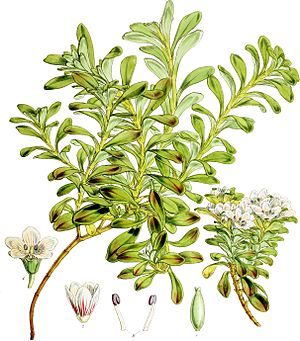Gentianella cerina facts for kids
Quick facts for kids Gentianella cerina |
|
|---|---|
 |
|
| Plate XXXVI | |
| Conservation status | |
|
Invalid status (NZ TCS)
|
|
| Scientific classification | |
| Synonyms | |
|
Chionogentias cerina (Hook.f.) L.G.Adams |
Gentianella cerina (also known as the Auckland Island gentian) is a special type of plant. It belongs to the Gentianaceae family, which includes many beautiful flowering plants. This gentian is found only in one place: the Auckland Islands of New Zealand. This means it is an endemic species, unique to those islands.
What Does It Look Like?
The Auckland Island gentian has a thick main stem, called a caudex. This stem can be either straight or have branches. It usually grows to be about 110 to 200 millimeters (about 4 to 8 inches) tall.
Stems and Leaves
Each plant can have 3 to 12 flowering stems. These stems are about 1 to 3 millimeters thick. Some stems grow straight up from the top of the plant. Other stems grow sideways along the ground, with their ends curving upwards.
The leaves are shaped like an oval, about 36 to 53 millimeters long and 8 to 12 millimeters wide. They are flat and have slightly thicker edges. The tip of each leaf is rounded. The leaf stem, called a petiole, is about 11 to 13 millimeters long. Leaves on the flowering stems are similar but smaller.
Flowers
Each plant can produce many flowers, from 15 to over 100! Each flower is about 9 to 14 millimeters long. The green outer part of the flower, called the calyx, is about 9 to 12 millimeters long. Small hairs grow where the calyx meets the petals.
The petals, which form the corolla, are about 8 to 11 millimeters long. They can be white or have hints of red or purple. You might see veins that are clear or purple. The bottom part of the petals forms a tube, about 2 to 4 millimeters long. The petal lobes, or individual petals, are about 6 to 8 millimeters long and 3 to 5 millimeters wide.
The pollen inside the flower is yellow. The stigma, which collects pollen, can be purple or clear. Each flower has many tiny ovules, from 13 to 37, which can become seeds. The seed capsule, where the seeds grow, is about 6 to 12 millimeters long. This plant usually flowers from December to April.
How It Got Its Name
The Auckland Island gentian was first described in 1844. A scientist named Joseph Dalton Hooker gave it the name Gentiana cerina. Later, in 1993, other scientists named Ho and Liu moved it to a different group of plants. They gave it the name it has today: Gentianella cerina. It now belongs to the genus Gentianella.
Protecting This Plant
This special plant is considered "At Risk - Naturally Uncommon" in New Zealand. This classification was given in 2009, 2012, and again in 2018 under the New Zealand Threat Classification System.
It is "Naturally Uncommon" because it only grows on the Auckland Islands. This means it lives in a very small and specific area. Because its home is so limited, it is more vulnerable to changes in its environment.

